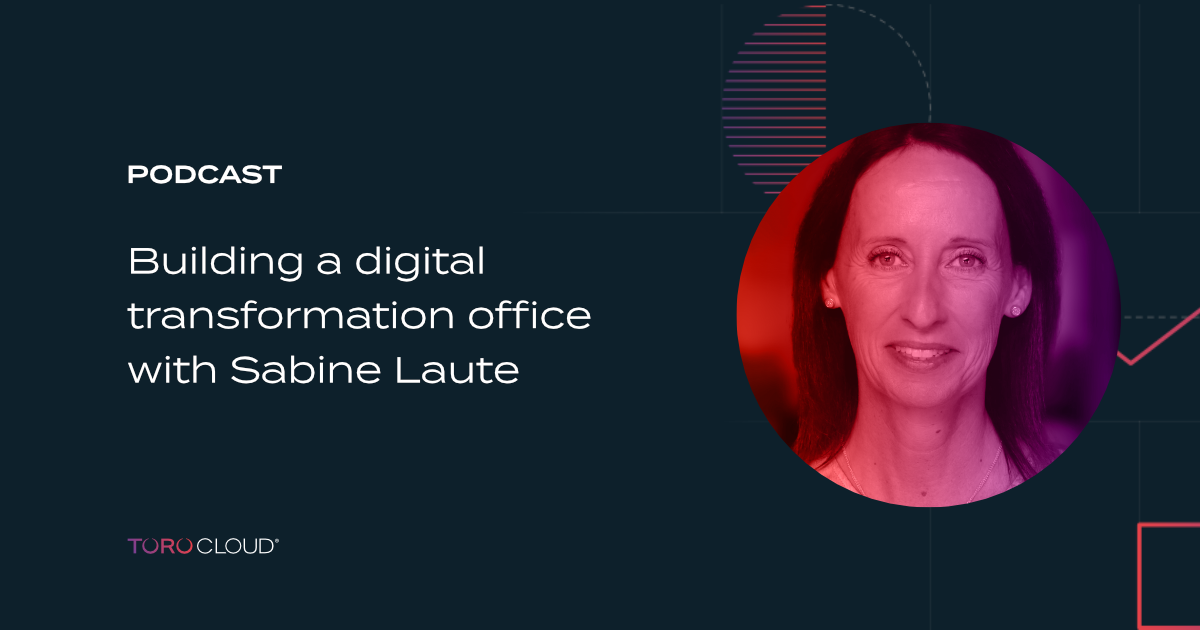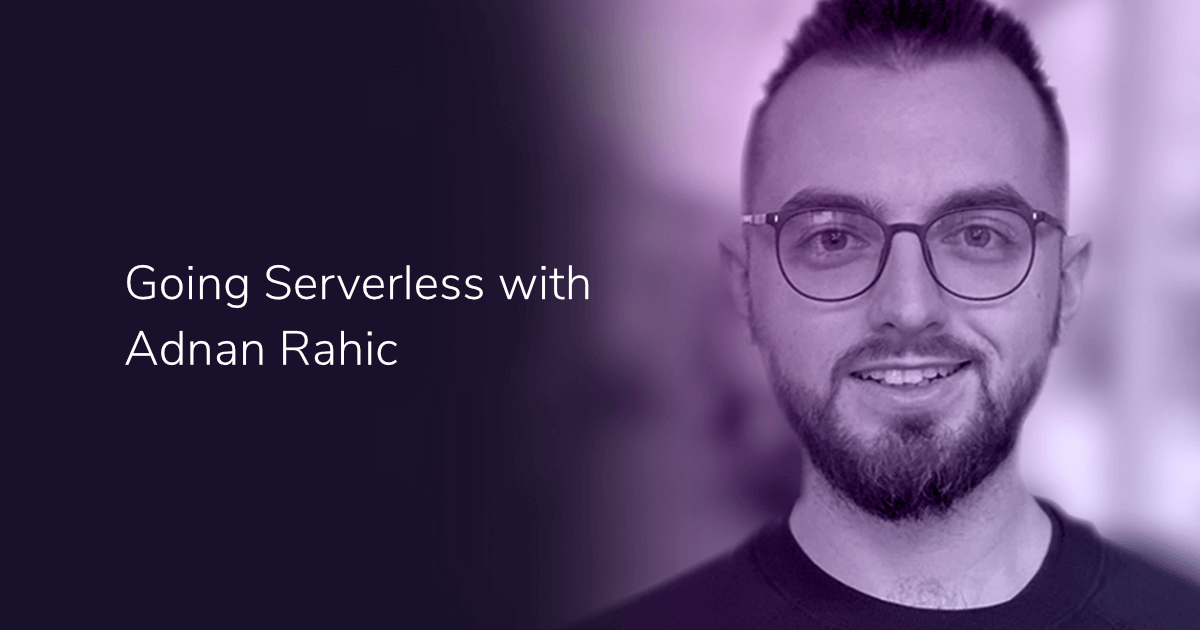
Episode outline
- Sabine Laute talks about her responsibilities as The Adecco Group's Senior Vice President and Regional Transformational Lead for DACH Countries and Northern Europe.
- Are there benefits to having a transformation management office inside an organisation?
- How can an organisation truly take advantage of investing in a transformation head or department?
- Who should be the “face” of digital transformation within an organisation?
- How do we address the challenges associated with behavioural and cultural change that goes with digital transformation efforts?
- Were companies able to take advantage of the time during the pandemic to truly digitally transform themselves?
Transcript
Kevin Montalbo
Welcome to episode 55 of the Coding Over Cocktails podcast. My name is Kevin Montalbo. On the show today, we're joined by the Senior Vice President and Regional Transformation Lead for DACH countries and Northern Europe at The Adecco Group.
She has more than 20 years of experience in advising senior leaders on strategy development as well as the conception and realisation of large international transformation projects. Her passion and track record is to drive the transformation and cultural change of companies towards agile organisations with a stable backbone.
Ladies and gentlemen, joining us for a round of cocktails is Sabine Laute. Hey Sabine, welcome to the show!
Sabine Laute
Hi, Kevin! Thank you.
Kevin Montalbo
All right. So first off, we'd like to know more about you. So, can you tell us more about what you do? What are the responsibilities of, as you are for DACH, a Regional Transformation Lead?
Sabine Laute
So, the main responsibility of the Regional Transformation Lead at Adecco is to translate the global transformation strategy in a country and regional transformation roadmap, and most importantly, to ensure the sustainable implementation. And the regions I'm responsible for, so Northern Europe in DACH covers countries from the UK: the Netherlands, Belgium, Luxembourg, Norway, Sweden, Finland, Germany, Austria, and Switzerland. And you can imagine, each country has its own culture, maturity in technology, change readiness, and available capabilities. So, this is the most crucial part, that we really take all of this into account. We need to ensure that the portfolio in the countries are digestible, manageable, resources and capabilities available, and most importantly, the strategy is understood and the expected impacts are delivered.
So, on the one hand, I'm in the middle between global and the countries. So, [I’m] the advocate of the countries, to make sure that they are not overburdened. But on the other hand, I really need to push them and get the countries to step out of their comfort zone and go along with the change. So, it's on the one hand to protect them, on the other hand, to push them to move ahead. And yeah, these 11 countries are all different.
Kevin Montalbo
And that's interesting. You have a very unique position within the company in order to influence change. We talk a lot about change in this podcast. And in one of our recent podcasts, we discussed that in an ideal world, a company would have someone like you or a counterpart, like a dedicated transformation management office. So, what are your thoughts on this, on the benefits of having a dedicated transformation office?
Sabine Laute
"...it's super important to have someone in the center, in a global transformation office, that enables the organisation to overcome functional silos..."
First of all, we are lucky we have a dedicated transformation office on a global level, embracing the whole transformation of the Adecco group. And I think it's really a benefit of having a dedicated transformation office, because if you embrace such a huge transformation in a global organisation, you need to have a team that orchestrates and directs all transformation initiatives that are running and will be started. It's super crucial to ensure that the initiatives have different functions. So, in our whole transformation business-related initiatives, we have support function- related initiatives and change management initiatives. And it's super important to really sequence them in the right way and ensure that these different functions are aligned.
So, if you have a huge organisation and if you want to start a global transformation, it's super important to have someone in the center, in a global transformation office, that enables the organisation to overcome functional silos, and making aware and managing the impact of the initiatives that haven't gone down the organisation. So, that means on the one hand, a constant focused-steering of initiatives and that managing the interdependencies is super important. And this is, from my point of view, the biggest benefit, including setting up the underlying change management and adoption roadmaps. So, constantly reviewing, are we still moving in the right direction? And are there initiatives supporting the vision?
Kevin Montalbo
You told us a while ago that you were responsible for several regions and countries in the DACH region. I was just curious how, when the pandemic hit, how you are managing those. Because, obviously, we couldn't fly to these countries. So, were you managing them all day from the comfort of your desk? Were you talking to teams? How did your typical day look like when the pandemic hit?
Sabine Laute
Yeah, first of all, I started meeting my team from the end of August onwards. And I've been in this role now since January. So, I really needed to build up the relationship via Teams. It was not possible otherwise. So I have, in each country, a transformation country team. And the most time I really spent on was building relationships and stakeholder management in the countries. It was a lot of talking. I think , like all of us, back-to-back calls from morning to late evening. And it's different, totally different than seeing people in person.
What we did [was] we really built a trusted environment from the very beginning. But it’s the difference. If you meet the people in person, there’s really a difference, especially when you meet the team behind the country transformation director. In the transformation leadership team, [there are] regular calls, and we really built up an open atmosphere with feedback culture and challenging each other and supporting each other, because during the pandemic and working from home, a lot of people feel alone and isolated and struggling with not having the direct connection with people.
But now, over the last month, I met my team in the Nordics. I met my team in Belgium and in the UK, and then got to know the people. This is such a big step in the right direction, especially for the people to get to know “Who is Sabine?” behind the Team’s screen. And we can laugh. We can have a drink in the evening and “Wow, she might be a senior vice president, but she's human and I can speak openly to her and come up with my ideas!”. So, this is super important to overcome hierarchies.
Kevin Montalbo
Yeah, it's very important to know that the person you're talking through is not just an AI behind a screen, right?
Sabine Laute
Exactly!
Kevin Montalbo
In this podcast, there are a lot of CEOs down to software architects listening to us currently. How can their organisation truly take advantage of investing in something like a transformation head such as yourself, or a transformation management office or department?
Sabine Laute
So, first of all, it's important that the organisation really wants everything that comes with a transformation leader. That means not only following a hype, because each and every organisation is looking for a transformation leader, but really the whole board needs to stand behind that. I had, in the last years before the pandemic, some interactions with C-levels in Europe. And for me, it became pretty clear fast [that] okay, every DAX 30 company has a transformation lead, so they need to have one as well. But there was not really the alignment behind it and what it means. So, they ask for transformation leads with virtual resources in different departments with 100% allocated jobs, with a kind of enrichment of jobs to support the transformation, no clear budget allocation, no clear governance. If you are thinking about this, forget it. You can stop investing even in one transformation lead.
But, if the organisation and the board really wants to make a difference and wants to start a journey, a transformation journey, then what I said before, you have someone who brings all the initiatives together and ensures that it goes in the right direction – then it's really an advantage in investing. But from my point of view, it's super important that if you have a smart organisation, you look for a diverse team. So, best case, not a whole team out of their own organisation, but take someone out of a different industry so you'll get a different view on things.
And you need to have an environment where these people, the transformation lead and the transformation team are allowed and are not afraid to speak up. These people shouldn't be biased, you know? Not just following what the executive board says, but really [being] able to challenge and to speak up. And they should have the freedom to call out if something is going in the wrong direction, may it be content or behavioral-wise.
So, if you have this in place or are willing to really support this, then the biggest advantage is to have someone in the organisation who really helps moving in the right direction and to change, and to adjust, and to make clear if something is going in the wrong direction. You shouldn't be afraid of losing a job in a nutshell.
Kevin Montalbo
Yeah. So, speaking of these characters, you're already diving into these individuals and the team who would form this transformation management office. Who should be the “face” of digital transformation within an organisation?
Sabine Laute
I think it should be the CEO, definitely the CEO. Because the CEO has one goal, and this is making a success for the whole organisation. He has not only the view of one function or business unit or whatever. So, he is able to oversee all functions and the CEO is the one who should really be the one telling the story about the purpose, about the vision, and to guide the organisation towards this purpose. So, from my point of view, the CEO is the one and only one, if you want to have a successful transformation. Digital [transformation] is not only technology. You need to change behavior and you need to change processes. And most of the time, you change your target operating model, right? If you’re embracing a new business model, this only can be really supported by the CEO from my point of view.
Kevin Montalbo
We agree with that, because recently we published an article actually on how digital transformation is more of a people problem rather than a technology problem, which is kind of strange because, you know, it's called “digital transformation,” but there's a 50/50 chance that your digital transformation can fail if the behavioral and cultural change doesn't materialise. So, as a transformation leader yourself, how would you address the challenges associated with these behavioral, cultural, and perhaps even psychological changes that go with digital transformation efforts within an organisation?
Sabine Laute
You will not get everyone behind it, but at least people will get excited with that and want to be part of that.
Yeah, I think the most important part is to have a clear “why.” So, why are we transforming and what are we doing and how? And this really needs to be not only communicated top-down, but it should really be cascading and it should come via dialogues. So, what does the change mean for the area I am working in, to get the fear out of all of this? So the unknown. What is coming? The organisation is doing a huge transformation. We need to overcome the unknowing for the people and especially what it means for me as well [is] how can I support, how can I contribute as an individual? And on the other hand, we need to make clear how the organisation supports me as a person to grow into that.
So, most of all roles change. Some roles are disappearing, some roles will change. You need to upskill your technology knowledge or you need to move into a new role. And I think it's super important for an organisation to take that into account at a very, very early stage. So, an organisation supports or people support what they are part of, and this is easier said than done. First of all, you need to have a purpose. You need to really come with a clear purpose. What do you want to change and how do you want to do that? And even this is the most difficult part to formulate in an understandable way and not very theoretically what you want to do. And this cascading, from my point of view, really needs to start at the top.
So, the senior leadership and board needs to understand itself. What does it mean? What does development mean? What does technology mean? What does digital leadership mean? What does Agile mean? Everybody knows the buzzword, but really what's behind that and the impact on their own role that needs to be understood? And I think there’s a need to invest heavily in these kinds of things like leadership programs, change management, and so on and so forth. If the senior leadership understands what is behind the strategy, then you can cascade it and start. From my point of view, it should be workshop settings, cascade it until you have the shop floor, because with every cascade, you have a more target-oriented compelling story. You come up with the same messages, but you always reach the different layers of the organisation. So, it becomes more and more individual. And I think this is super important. You will not get everyone behind it, but at least people will get excited with that and want to be part of that.
Kevin Montalbo
So, speaking of that cultural and behavioral change, the people aspect of the transformation that most companies face can be a very multifaceted and a very layered problem. So, whilst there has been a lot that has been written and said about the technological requirements of transformation; you know, business and IT merging, IT people getting into boardrooms more and more. The more personal and behavioral aspects, such as resilience, ambiguity, and being comfortable within the discomfort of change can get overlooked. So, how do you think organisations and transformation leaders should address this?
Sabine Laute
Again, I think, and this is connected to my answer before, leaders need to be able to deal with all of that. And this is not done by reading articles or listening to keynotes. I think it's super important to really invest in a leadership program that helps leaders to deal with discomfort and to be comfortable with constantly changing an unclear environment. I mean, who thought about COVID two years ago? No one. Right? And from one minute to the next, leaders needed to change. Managers, I met a lot of managers, not even leaders. So, managers needed to change how to guide the teams. And doing that without support, I think it won't work because transformation is not that black and white. It's more [like] 500 shades of gray, right?
You don’t know what is coming next year. It can change overnight. So you need to adjust. And if we don't support it, this ambiguity can really lead to the opposite effect. If you need to do your existing business in order to earn money, but at the same time, you as a leader or as a team are asked to support a transformation strategy where you don't know where it's going, this is a scary situation. You don't know if your existing business model will survive, where you are incentivized, right? But on the other side, you know that the organisation somehow is working on something that will probably change the way I need to work or the business model or whatever. And if you don't feel safe or you can’t deal with that, that really leads to frustration, the blocking of change and even burnout.
And if leaders are not able to support their teams in that, this will be a disaster and you will have a huge retention. People are leaving because we have an employee market right now. So there are a lot of vacancies that are hard to fill. And yeah, this is so crucial. So, from my point of view, a kind of leadership program should focus on three aspects. One is the upskilling of leaders and digital learning journeys, such as Agile mindset and methods, how new product development works, megatrends, and then the exponential development of technologies and what that means for their business.
So to become aware that I'm not safe in my role, I won’t do the same thing over the next 20 years. If I'm a controller, even then when you think, “Okay, controlling X to five, blah, blah, blah…” even that will change.
And this needs to really be a good part of your understanding. The second aspect should be behavioral aspects. And that means in this new environment, how do I, as a leader, need to behave? I think micromanagement, command-and-control, isn't the culture that embraced these kinds of transformation. It's more about leading through purpose and deliverables, even if, especially if you're remote working. You can't sit next to a team member and control – if the person is starting at nine and leaving at five, now it's about really leading via deliverables and purpose. The other thing is to trust and empower the team as well, [which is] super important right now. I need to trust my team, that they are not sitting at home and watching funny shows in the afternoon or whenever, and to trust them that they're really doing the job.
And this is two: deliverables, right? And the third one is for me [which is] super important [is] connecting people. So really, to build up networks and make senior leaders accessible for teams. So, really lower the hierarchy. The third aspect of a leadership program, this is about strengthening our capacities. And here, I'm talking about mindfulness. So, working with emotions, feelings and mindfulness. And with this, I don't mean screaming at people, but really to be mindful and to try to embrace it, embracing and seeing what's going on around yourself. If I, as a leader, don't be at my best, I can't support my team at my best and can't deal with the uncertainty and difficult situations the teams have, probably.
And then systemic perceiving. So really, with systemic perceiving, I mean, when you start a huge transformation, I think it's important to understand what potential blocking patterns we have in this organisation to really embrace a change that could be working in silos, that could be delegating responsibilities with other authorities, and so on and so forth. And if you identify the blocking patterns, it's super important to really be open and observe and see if we are falling back, and blocking patterns, and to call it out. And this needs to be trained, to be learned. There are several tools, method [on], how we can always lean back and embrace these capabilities.
Kevin Montalbo
Talking about embracing capabilities and embracing change within the sphere of the global pandemic., let's talk about, you know, whether the companies really took advantage of the time during the pandemic to digitally transform themselves. So, as we're recording this, we’re already at the tail end of 2021. Looking back, did you really see, perhaps in your own personal experience or perhaps what you've heard from in your network or read in the news: Do you think companies really took advantage of when the pandemic hit to digitally transform themselves, or were they just responding to a one-off event that forced them to implement protocols such as remote working and remote customer service, but missed the opportunity for true digital transformation? What's your opinion of that?
Sabine Laute
I think there is no “either/or” answer, and really, it depends on the maturity of the organisation. I think there are a lot of organisations that really need to catch up. I mean, in Switzerland and in Germany, for example, both countries I lived in during the pandemic, especially in Germany there partly wasn't even home office formalised. So, that means overnight, people were sent home and not everybody had a laptop, or you can imagine that probably no wifi at home. So, first of all, the infrastructure needed to be in place. And then letting people go and not being able to control them from morning until evening, whether they are really sitting at that table, that was something a lot of companies needed to catch up on very fast.
But this was an advantage as well, because I think if the pandemic wouldn't have happened, we would still be in this area. There were a lot of lessons learned and a lot of managers who said this will never work. We will drop our profitability, blah, blah, blah. They're really convinced now that this is not happening. People are working more. We need to really take care of that, [that] they're not working too much back-to-back in calls. So I think a lot of companies used the last one and a half years to catch up in terms of policies, in terms of enabling people working remotely from home, as well as to serve the customers remotely. And other companies who were quite ahead, I think they could use this as an advantage to really aggressively and speed up their digital transformation because a lot of opportunities for new business models came up. And if you started thinking and working on that years ago, and not only now when COVID came, they definitely had an advantage.
Kevin Montalbo
Remote working is just the tip of the iceberg for digital transformation, right? So, how would you go beyond that? How would you define true and authentic digital transformation as we move forward from the pandemic?
Sabine Laute
A true digital transformation for me is if an organisation really thinks beyond what they are doing right now and not only securing their business as is.
How do I fully define digital transformation moving ahead of the pandemic? I mean, the most important part is the adoption, right? When you start, when you do the digital transformation, I think the most crucial part is really that the digital transformation enables us to react faster in the future. Business models or businesses will disappear. Others will come up. And a true digital transformation for me is if an organisation really thinks beyond what they are doing right now and not only securing their business as is.
But, it's not stoppable. We won't go back full-time in the offices. We will have the flexibility. The employee experience, the customer experience, this for me is the most important part. Because through the pandemic, I mean before even, we are using all the digital gadgets in our free time. We are booking our vacation on Booking.com or whatever. And this is a really great experience. And if companies don't really deliver the same experience for the employees and for the customers in the future, then this is a missed opportunity. And I think this, speaking for all organisations and governments, by the way, [was] the worst part I saw via the COVID pandemic. This should be, really from my point of view, the biggest next step.
Kevin Montalbo
All right. Sabine, you've been great at giving us all the advice from a very personal and professional experience. Where can our listeners go to follow you? What you do and your thoughts about digital transformation and all this stuff.
Sabine Laute
I'll be on LinkedIn and this is the platform where I'm most active.
Kevin Montalbo
All right. Thank you very much for joining us today! I hope you had a grand time.
Sabine Laute
Thank you!
Show notes:
- Sabine Laute on LinkedIn











